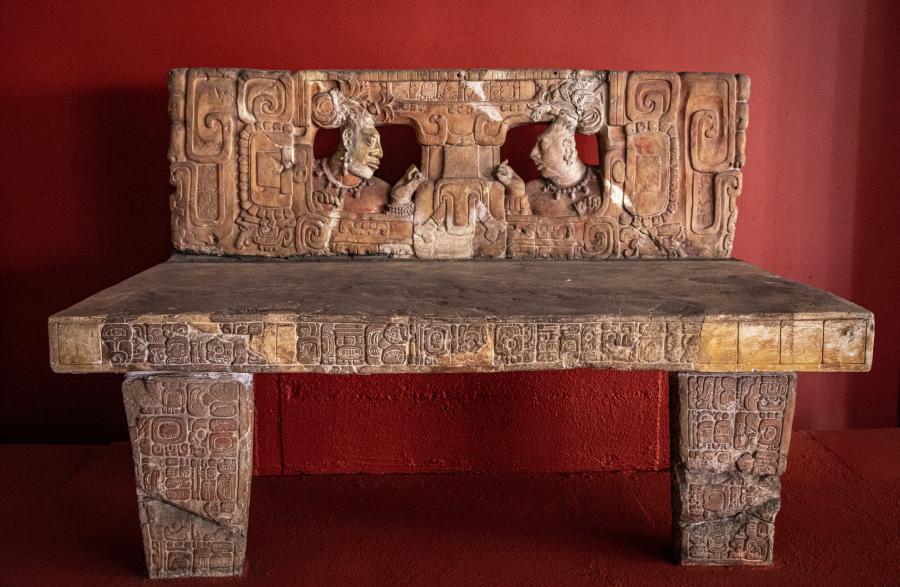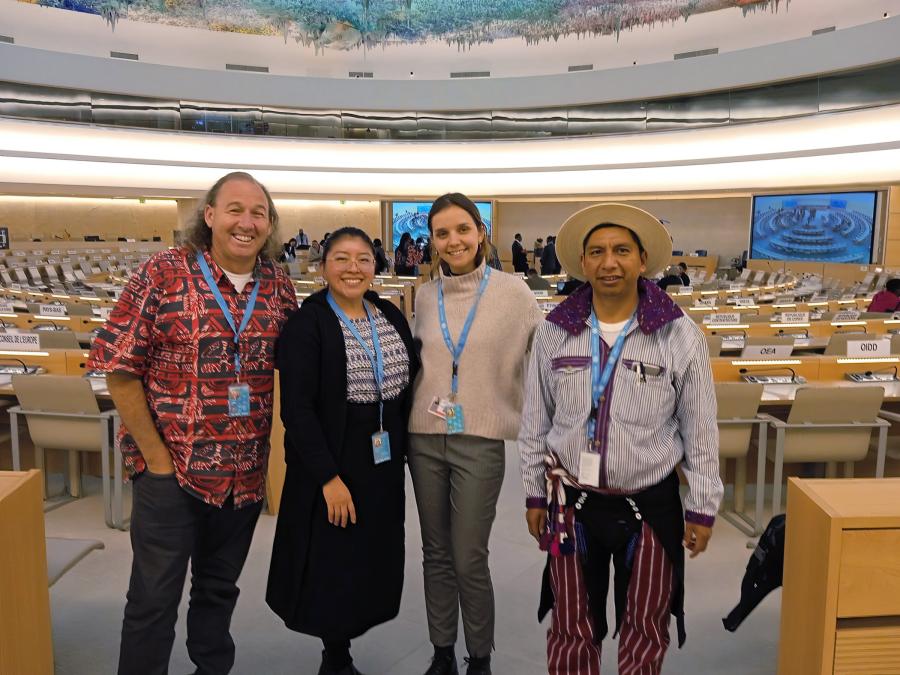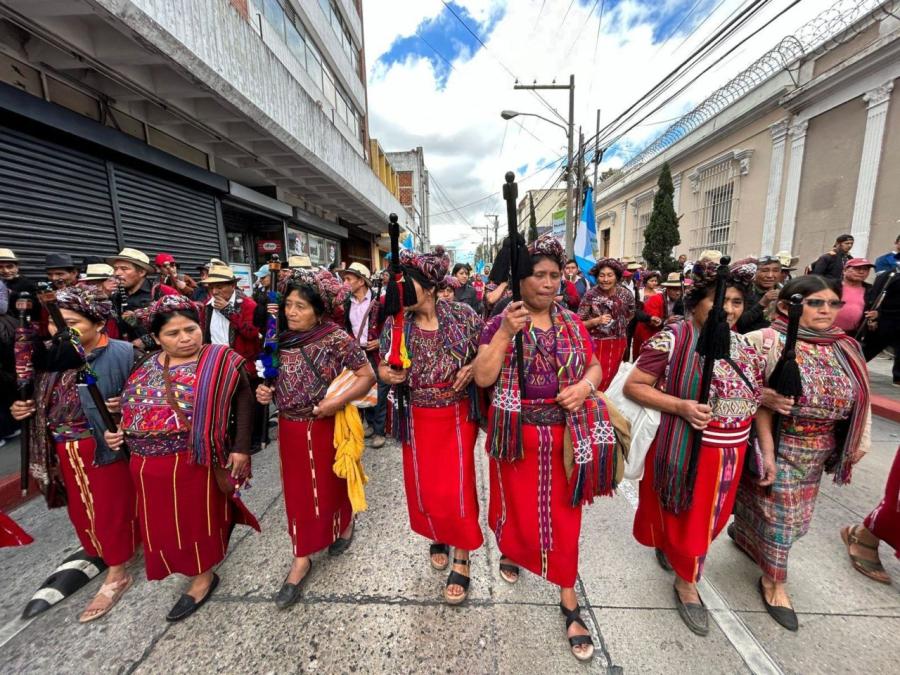
On February 8, 2014, 55 youth from Guatemala, Belize and El Salvador gathered in Panajachel, Sololá, Guatemala for Cultural Survival's First Central American Youth Forum. This event was the third and final in a series of youth conferences that Cultural Survival organized with three grassroots Indigenous organizations: Tumul K'in Centre of Learning (Belize), ADECCAP (Guatemala) and Africa 70 (El Salvador). The same youth that participated in the two prior events, met once again at beautiful Lake Atitlán, greeting each other with hugs and smiles in the early morning sun.
The same youth that participated in the two prior events, met once again at beautiful Lake Atitlán, greeting each other with hugs and smiles in the early morning sun.
The event kicked off with a Mayan ceremony led by spiritual guide Nana Maria Feliciana Ujpán. She commenced by having everyone kneel down and raise their hands, feeling the energy of the lake, of the sun, and of their ancestors, providing positive energy for this final encounter. All participants held hands in a circle, unifying spirits and asking for a fruitful final conference, and for success in all future projects and endeavors.
[[{"fid":"62230","view_mode":"media_original","fields":{"format":"media_original","field_file_image_alt_text[und][0][value]":"","field_file_image_title_text[und][0][value]":"","taxonomy_vocabulary_8[und][]":"2676","taxonomy_vocabulary_14[und][]":"2878","field_caption[und][0][value]":"","field_copyright[und][0][value]":"","taxonomy_vocabulary_16[und]":"_none","field_media_page[und]":"1","field_folder[und]":"3046","field_tags[und]":""},"type":"media","attributes":{}}]]
The main goal of this project was to improve integration and participation for Indigenous Central American youth, using community radio as a tool. At the prior events, the youth learned about their shared histories, the history of community radio, and Indigenous values, among other topics. They practiced investigative journalism and gained experience presenting for radio and in front of their peers and elders. The forum was organized to motivate the youth to create their own projects following the closing of this training series. One participant acknowledged the need to work together with other Indigenous youth from different countries stating, “It seems like were are from different countries, but really we are all united as one community. We need to erase the imaginary lines that divide Central America.”
On the first day of the event, youth worked in groups, tackling important questions in creative ways. They participated in a scavenger hunt, searching the premises for their groups’ questions. Once they found and answered a question, they could grab their next clue card. Some of the questions included, “How does community radio deal with youth issues in our communities?”; “What are the most important social issues that are affecting Indigenous youth in our communities?” Following this activity, the youth groups presented their ideas to each other, then they reached consensus regarding which issues were most relevant to their communities and which issues most deserved follow-up projects.
[[{"fid":"62232","view_mode":"media_original","fields":{"format":"media_original","field_file_image_alt_text[und][0][value]":"","field_file_image_title_text[und][0][value]":"","taxonomy_vocabulary_8[und][]":"2676","taxonomy_vocabulary_14[und][]":"2878","field_caption[und][0][value]":"","field_copyright[und][0][value]":"","taxonomy_vocabulary_16[und]":"_none","field_media_page[und]":"1","field_folder[und]":"3046","field_tags[und]":""},"type":"media","attributes":{}}]]
The topics that the groups chose were discrimination, Indigenous rights, youth issues, and history. Youth were given the responsability to create real project proposals that tackled the identified issues in their various communities. They had to take into consideration distance, the lack of funds and all other difficulties that they might encounter. The youth groups worked together, guided by facilitators who stressed the importance of making these project proposals viable, under the expectation that these would be real projects that the youth would have to execute.
That night, Tzutu, a Maya Tzutujil hip hop artist from San Pedro la Laguna, performed. Tzutu creates conscious hiphop music, through which he discusses issues such as Mayan Cosmovision and the importance of being in touch with ones roots. Tzutu provided each person with a candle, and as the concert went on, each person placed their candles into his clay pot, where he was burning copal and other fragrant herbs. Twenty-five of the attendees spoke Tzutujil, so they understood the music on a different level than the rest. For those who didn’t speak Tzutujil, however, there was no lack of connection. As one youth stated in his or her evaluation form for the event, “The hip hop concert was incredible. It isn’t everyday that you see that kind of mix between Indigenous and mainstream culture. It made me feel really proud to be Indigenous”.
[[{"fid":"62233","view_mode":"media_original","fields":{"format":"media_original","field_file_image_alt_text[und][0][value]":"","field_file_image_title_text[und][0][value]":"","taxonomy_vocabulary_8[und][]":"2676","taxonomy_vocabulary_14[und][]":"2878","field_caption[und][0][value]":"","field_copyright[und][0][value]":"","taxonomy_vocabulary_16[und]":"_none","field_media_page[und]":"1","field_folder[und]":"3046","field_tags[und]":""},"type":"media","attributes":{}}]]
The next morning, the youth arrived in the conference room ready to present their project proposals. The group with the topic “Indigenous Rights” decided that their project proposal would be to create a Facebook page dedicated to Indigenous rights. They recognized that this proposal is one that is viable, considering the distance between the group members, and that it is a great tool for sharing information and creating networks. They planned on creating a team who would search for issues that were happening internationally and teams that would update about their own communities. The page would share stories regarding both Indigenous rights violations, as well as communities who are fighting to protect their rights. As Mauricio Guerrero, one of the youth panelists commented, "The majority of youth now use social media. Do we have access to Facebook? The majority of us do. But we have to use these mediums productively. There we have to influence others and fight against discrimination against our Indigenous communities”.
[[{"fid":"62234","view_mode":"media_original","fields":{"format":"media_original","field_file_image_alt_text[und][0][value]":"","field_file_image_title_text[und][0][value]":"","taxonomy_vocabulary_8[und][]":"2676","taxonomy_vocabulary_14[und][]":"2878","field_caption[und][0][value]":"","field_copyright[und][0][value]":"","taxonomy_vocabulary_16[und]":"_none","field_media_page[und]":"1","field_folder[und]":"3046","field_tags[und]":""},"type":"media","attributes":{}}]]
After the presentations, the event closed with the youth participants making commitments to proceed with the projects that they themselves had designed. They fleshed out the proposals, detailing who would take what role, and what each role entailed. Then, they signed their names next to their roles, with their contact information, making a commitment to continue with their projects after the closing of the event. For each project, at least one coordinator was assigned, and in some cases, one coordinator per country. These coordinators closed the event by presenting their groups name, its main objective, and all of the members’ names and roles. These coordinators also accepted the responsibility of organizing their group members after the closing of the event so that they may move forward with their projects.
The youth expressed deep gratitude for having participated in the project. Motivated to make a difference in their communities and in Central America, one youth stated, “We are going to do something, even if it is something small. Let’s be the black dot in the monstrous white that is the monopoly of the mediums of communication."
This event was made possible with the generous support of our donors and FLACSO Costa Rica, FLACSO El Salvador, PNUD, Unión Europea, and PAIRCA II.



